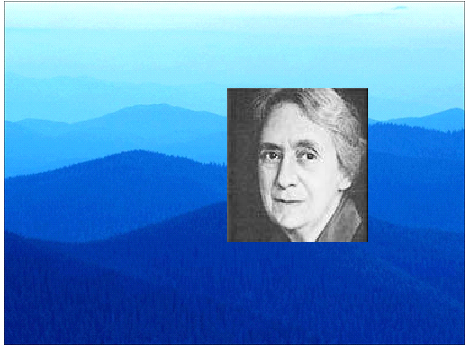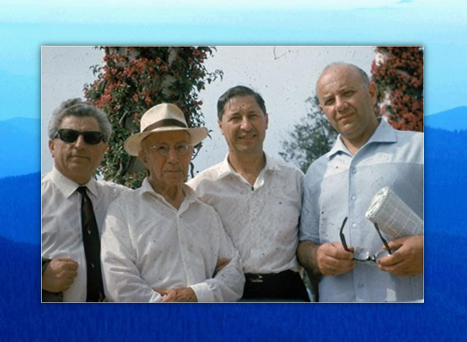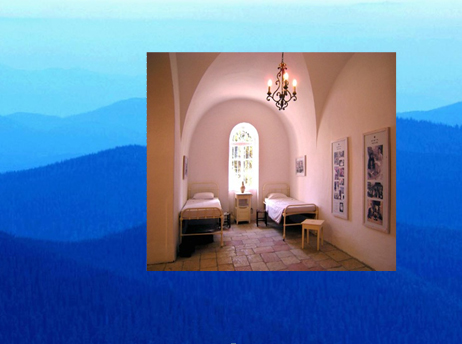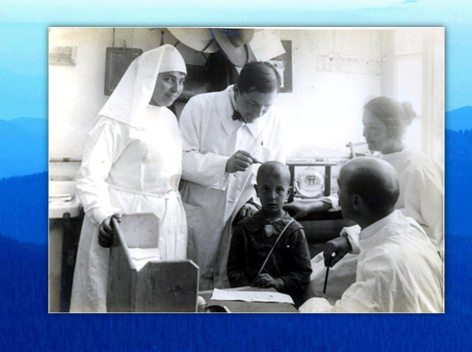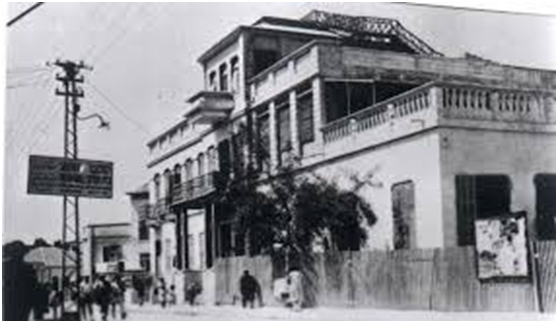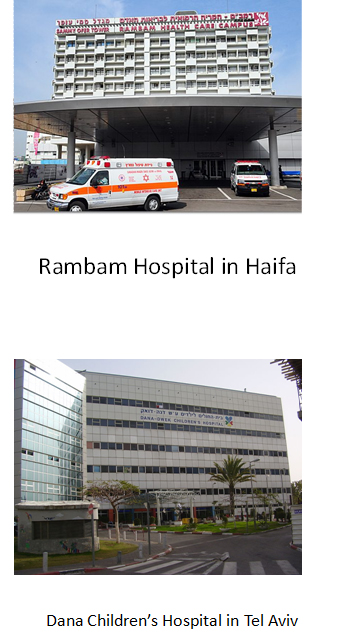Geography and population
Israel is a country in the Middle East, located on the Mediterranean coast, which declared its independence in 1948. It has a parliamentary democracy and is defined as a Jewish and democratic state. The population of Israel is seven and half million inhabitants. Most of the state residents are Jewish, but there is a large Arab minority of about 20%. It is comprised mostly of Muslims, though other minorities are also represented.
Israel is bordered by the Mediterranean in the west, Egypt in the southwest, the Red Sea in south, Jordan in the east, Syria in the northeast and Lebanon in the north. The capital of the state of Israel is Jerusalem and it is the largest city in the country, with 829,900 residents. The city is sacred to Judaism, Christianity and Islam.
Dermatology
In Israel there are seven departments of dermatology in the following hospitals: Rambam Hospital in Haifa ( Present Chairman: Prof. Reuven Bergman),Haemek Hospital in Afula(Present Chairman: Dr.MichaZiv), Ichilov Hospital in Tel Aviv (Present Chairman: Prof. Eli Sprecher),Shiba Hospital in Tel Hashomer (Present Chairman: Dr. Aviv Barzilai), Rabin Hospital -Campus Beilinson in PetachTikva(Present Chairwoman: Prof.EmmiliaHodak) , Hadassah Hospital in Jerusalem (Present Chairman: Prof. Abraham Zlotogorski) and Soroka Hospital in Beer Sheva (Present Chairman: Prof. Dany Vardy). All the seven are university affiliated departments with three units of pediatric dermatology in Children’s Hospitals. In most departments of dermatology in Israel is also a clinic of pediatric dermatology. Three Units of general dermatology are located at different hospitals. In every hospital there is a consultant dermatologist.
Active expert dermatologists number 372.Every year 5-10 residents finish the residency and pass the Board Examinations. Most of the dermatologists are working in the community (90%) only about 10% are “academic”, working in the departments of dermatology. Only a few are full timers and the most are part timers.
Residency in dermatology is 5 years. 3.5 years are spent in dermatology, 6 months in internal medicine,3 months in plastic surgery, 6 months in basic science, 3 months elective in wide variety of specialties such as: genetics, endocrinology, pediatrics, psychiatry, dermatopathology and many more. Two board examinations are given: a written one in the middle of the residency and an oral examination in the last year of residency. Residencies in Israel are strictly supervised by the Scientific Council which is a national official part of the Israel Medical Association.
Scientific activities
Medicine in Israel is practiced on a very high standard and is considered as one of the best, in some areas leading the world. Dermatology in Israel always had a high level but in the last decade tremendous progress has been made in Israeli dermatology. Much more basic and clinical studies are done with international collaboration. Almost in every international dermatological meeting one can find a few Israeli speakers. About 50 studies in basic and clinical dermatology are done each year in the departments of dermatology in Israel, most of them are published in leading Journals.
Dermatological surgery and cosmetic dermatology
In the last two decades there is anaccelerated development of these fields in Israel. Israeli dermatologists are on the highest level, leading the region. Israeli dermatologists perform plastic surgery, Mohs surgery, cosmetic treatments of all kinds, laser treatments and more. In certain areas of surgery and cosmetic treatments, Israeli dermatologists are world-leading. Many leading studies are done in these areas.
Historical background
The history of modern medicine in Israel began with the vision of Henrietta Szold (1860-1945). She was born in Baltimore,Maryland, USA as the eldest of eight daughters of Rabbi Benjamin Szold, the spiritual leader of Baltimore’s temple “Ohev Shalom”. In 1896, one month before Theodor Herzel published his magnum opus “Der Judenstaat” (The Jewish state), she described her vision of establishing a Jewish state, Israel.
In 1912, Henrietta Szold founded the Hadassah Organization, afemale American Medical Zionist Organization dedicated to support health, education and welfare of the Jewish community in Israel (Palestine at that time). In 1920 at age 60, Henrietta Szold immigrated to Israel. In 1921, the Meir Rothschild Hospital (established in 1854 in Jerusalem by the Rothschild family of France) changed its name to Hadassah Hospital as the hospital of the Hadassah Medical Organization.
In 1913, a clinic of dermatology was housed in a rented structure adjacent to Meir Rothschild Hospital. In 1919, the first department of dermatology in Israel was established and moved into the hospital. In 1920, Prof. AryeDostrovsky was elected to be the first head of the department of dermatology.
Founding fathers of dermatology in Israel [1]
Prof. AryeDostrovsky, the founding father of dermatology in Israel (1887-1975): AryeDostrovsky was born in 1887 in the village of Kiro (Crimea, Russia). In 1914, he finished his medicinal studies in Vienna and in 1917, he completed his specialization in dermatology and venereology in Petrograd. In 1919, he immigrated to Israel (Palestine). In 1920-1956, Prof. Dostrovsky served as the head of the department of dermatology in Hadassah hospital in Jerusalem.
The first medical school in Israel was established in Hadassah hospital in 1949 affiliated to the Hebrew University in Jerusalem. Prof. Dostrovsky was one of the first professors in the medical school. He served also as the first director of Hansen Hospital in Jerusalem for leprosy patients. Prof. Dostrovsky was also the pioneer of climatotherapy for dermatological diseases at the Dead Sea. He was the first to recognize the efficacy of Dead Sea treatment for psoriasis. He had an international reputation and he promoted Israeli dermatology. His researches included: ringworm disease among Jewish and Arabic children in Jerusalem, leprosy, urticariapigmentosa, leishmaniasis, venereal diseases and Dead Sea treatment for psoriasis.
Prof. Felix Sahger (1808-1981): Prof. Sahger was the son-in-law and the successor of Prof. Dostrovsky. He was born in Innsbruck Austria. He studied medicine in Prague(1926-1932) and was resident in dermatology in Prague(1932-1938). In 1939 he immigrated to Israel and started to work in the department of dermatology at Hdadssah Hospital in Jerusalem. After the retirement of Prof. Dostrovsky, he became the head of the department (1956- 1978). He continued Prof. Dostrovsky's research efforts and he waspartner in most of them.He was internationally very well known, and was a member of many international dermatological societies and boards.
Prof. ItzhakKatzenelenbogen (1896-1971): Born in the Polish city of Lodz, Prof. Katzenelenbogen studied medicine in Gretz, Austria from 1915 to 1921, after which he specialized in dermatology and venereology under Prof. Hermann in Vienna, Prof. Bushke in Berlin, Prof. Gougerot in Paris and Prof. Archibald in London. In 1924 he immigrated to Israel and he worked at BikurHolim Hospital as director of the Dermatology and Venereology Clinic. During 1932–1940 he also managed the Dermatology and Venereology Clinic attached to the German Hospital in Jerusalem.
In 1957, Prof. Katzenelenbogen was appointed the first director of the Department of Dermatology and Venereology at Beilinson Hospital in Petah Tikva (Today Rabin Medical Center). In 1960 he received the title Clinical Associate Professor at the Hebrew University in Jerusalem and in 1965 was appointed Professor of Dermatology at Tel Aviv University. He retired from the directorship in 1967. He died in 1971.
Prof. Katzenelenbogen was well known in the dermatology community around the world. He researched leishmaniasis and wrote extensively on the immunological aspects of the disease and described the pathergy ("Katzenelenbogen sign") of Behcet's disease, as well as the subtropical variant of lichen planus, known today as lichen actinicus.
Prof. SalimHaim (1919-1984): Prof. Haim was born in Bagdad in 1919 and in 1944 received his M.D. degree at the Royal College in Baghdad. He immigrated to Israel in 1951 and worked at Prof. Ziperkowsky's side in the Dept. of Dermatology and Venereology at Tel Hashomer Hospital. In 1954 Prof. Haim worked as an army physician at the #10 Hospital in Haifa. In 1957, he established the dermatology and venereology department at Rambam Hospital in Haifa, serving as department head until his death in 1984. In 1973 he received his associate professorship in Dermatology and Venereology at the Technion Faculty of Medicine in Haifa and in 1979 became full professor.
Prof. Haim's extensive research of Behcet's disease made him famous worldwide. In his research efforts, his basic assumption was that dermatological diseases are systemic diseases, and in his many studies attempted to prove this approach. He was one of the first teachers at the Technion Faculty of Medicine in Haifa.
Prof. AnatolKrakovsky (1924-2002): He was born in 1924 in Vilnius.His father was a famous Rabbiand in his father's family were well known Rabbis. After the Second World War, he began his medical studies in Poznan but a year later moved to Geneva, graduating in 1951.He specialized in Dermatology with Dr. Rudolph Ber and eventually immigrated to Israel in 1955. In 1967, he was appointed head of the Department of Dermatology and Venerealogy at Ichilov Hospitals in Tel Aviv (Hadassah-Tel Aviv at that time).
Prof. Krakovsky was an excellent dermatologist, an exceptional teacher, and extensively literate. He had a very broad education and a charismatic personality, and was a close personal friend of leading dermatologists throughout the world at that time.
Prof. Leo (Arye) Ziperkowsky(1909-1971): Prof. Ziperkowsky was born in 1909 in Greivo, Russia. From 1932 to 1934 he studied medicine in Bonn, Germany, but due to the rise of the Nazi regime in 1934 he immigrated to Israel. Later he completed his medical studies in Basel. In 1938 he returned to Palestine, enlisted into the British Army and specialized in Dermatology and Venereology in Alexandria, Egypt. He then took up a position as an army physician in Her Majesty's Armed Forces. In 1950 he established the Department of Dermatology and Venereology at Tel Hashomer Hospital. During the 1960s he was appointed Professor of Dermatology and Venereal Diseases at the Tel Aviv University School of Medicine, which was founded at that time.
In 1948, together with Professors Sheba, Heller and Padeh, he founded Tel Hashomer Hospital one of the leading hospitals in Israel.
Dr. Fela Zukerman (1935): Dr. Zukerman was born in 1935 in Sambour, Poland. She studied medicine between 1953 and 1957 at Werclev in Poland, and immigrated to Israel in 1957 where she continued her medical studies at the Hebrew University School of Medicine, graduating in 1960. Between 1962 and 1968 Dr. Zukerman specialized in dermatology and venereology at Hadassah Hospital in Jerusalem. In 1970, she established in HaEmek Hospital in Afula the department of dermatology.
Dr. Zukerman was a member of the founding generation of dermatology and venereology in Israel. She was an excellent clinician and an outstanding teacher beloved by her students. She promoted significantly dermatology in the northern part of Israel.
Prof. Sima Halevy (1948): Prof. Sima Halevy was born in Israel and studied medicine at the Sackler Faculty of Medicine at Tel Aviv University, graduating in 1972. Between 1975 and 1980 she specialized in dermatology and venereology at Beilinson Hospital in Petah Tikva (today, Rabin Medical Center). In 1989 she established the department of dermatology in Soroka Hospital in Beer Sheva and since then, she is directing the department. She is a well-known expert in drug eruptions. She significantly promoted dermatology in the "Negev" the southern part of Israel.
Hansen Hospital in Jerusalem
This hospital was established in 1887 by the community as the German Jesus HilfeAsyl (Jesus Help Asylum) for the benefit of leprosy patients in Israel. It was designed by Conrad Schick, a German missionary and self-taught architect.In 1950, the Moravian Church sold the entire compounds to the Jewish National Fund, following which the Israel Ministry of Health took over the running of the asylum and renamed it the Hansen Government Hospital.
The medical care was given always under the supervision of the department of dermatology at Hadassah Hospital.
Since 2009 Hadassah took over the running of the hospital. Recently the hospital moved to a new campus in the down town of the Jerusalem and the historical building became a museum with a permanent exhibition on the history of leprosy in Israel. It combines past and present and enables the visitor to experience the unique human and cultural story as well as gain an impression of its beautiful structure.
The directors of the hospital were:
- 1920-1949: Prof. AryeDostrovsky
- 1949-1977: Prof. Felix Zahger
- 1977-1981: Prof. Jacob Sheskin
- 1982-2002: Dr. AvigdorLivyatan
- 2002- 2015: Dr. Leon Gilad
- 2015-present: Prof. AlonMozes
Today the hospital takes care of about 200 leprosy patients. Every year 5-10 new cases are diagnosed, mostly amongst foreign workers from the Far East and Africa.
References
- Ingber A (2008) History of Dermatology and Venereology Medicine in Israel: The “Founding Fathers”. Israel Medical Association Journal (IMAJ) 10:406–409.

